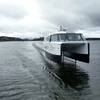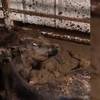Community Involvement
Given the sheer enormity and fluidity of the STCW-95 Code, it became abundantly apparent to MITAGS and to our trustee companies that organizations and mariners would need substantial assistance in complying with the Code. Therefore, we began a complete revision to our curriculum, which meant that we would have to commit substantial resources to assist in this effort.
The Global Marine Distress Safety System (GMDSS) was an early example of the issues associated with the implementation of STCW-95 Code. Right from the beginning, MITAGS advocated meaningful GMDSS training curriculum standards. MITAGS understood that, in a distress situation, a mariner's best opportunity for survival would be a complete knowledge of GMDSS procedures.
Another example was the recent FCC/USCG decision to adopt the same "question pool" for exams. This eliminated the somewhat bizarre situation in which the FCC answers contradict the ones developed by the USCG. MITAGS and other training institutions expertise helped make this happen.
MITAGS is also a charter member of the Ship Operators Cooperative Program (SOCP), a program that was initiated by the Maritime Administration (MARAD). This organization works on various issues confronting the maritime industry. As SOCP operates without government funding, each member must commit to a substantial initiation fee and dues. The organization works on a wide range of topics, including STCW, ballast water management, dry-docking, fuel oil analysis, and maritime security. In the fall of 2001, MITAGS was recognized for its active participation in the various working groups, including the "SMART" Card working group that is receiving a great deal of attention these days.
At MITAGS, we also saw the need to summarize and to condense the thousands of pages of STCW-95 directives issued by the Coast Guard. MITAGS developed monthly updates and checklists for students, companies, and trade organizations free of charge to assist them in understanding the Code. MITAGS also volunteered to co-chair the STCW-95 Problem Solving Working Group. Established in May of 2001at the Mariners Recruitment and Retention Conference, the group seeks to resolve common problems related to the implementation of the Code. As part of this process, MITAGS provided a model to show industry how the methodology of training mariners for original / upgrade of licenses will change after February 1, 2002.
Another new service is a free license expiration notice service. Mariners taking courses at MITAGS provide the Registrar with up to ten dates they desire to track. The Registrar then sends a reminder six months prior to the document's expiration.
New Partnerships for Success
Along with the required STCW-95 curriculum, MITAGS works with its trust companies, state pilots associations, military organizations, and other clients in solving industry safety and operational issues. Each new program is carefully structured to meet the full expectations of all stakeholders. The following are some examples of custom programs that met specific company/industry sector needs.
After several highly publicized shipboard fires, Carnival Cruise Lines’ wanted to develop a new approach to this type of training. They chose MITAGS because of its leadership in developing well- defined programs that meet company and regulatory agreements. The pilot programs included onboard training in fire control (Advanced Fire Fighting or AFF), and the development of a new Rapid Response Investigative Team (RRIT) to reach an incipient fire with two minutes of an alarm.
MITAGS was also tapped to provide the training for the historic partnership between the United States Coast Guard and the Louisiana State Pilotage Associations to operate the Vessel Traffic System on the Mississippi River. This innovative program included training and operation of VTS system, portable piloting units, automatic identification system, (AIS) and command and control procedures. Recently, MITAGS hosted an international seminar on this topic that included representation from most of the European pilotage organizations.
MITAGS also partnered with Patriot Holdings, MMP, MEBA, and the Calhoun Engineering School to develop the military training programs needed for the Bob Hope Class LMSRs operated by Patriot for the Military Sealift Command (MSC) and the U.S. Army. These ships required new skill sets at MITAGS in the areas of force protection, small arms, chemical and biological defense, military communications, and other programs. The lesson learned from these programs is now being offered to the industry as examples of what companies and mariners can do to better secure their assets against terrorist attacks.
As with any new program, MITAGS looked beyond the minimum requirements and sought to establish the model curriculum. MITAGS hired Jack Lynch, a retired U.S. Navy SEAL, to set up and teach the small arms, force protection, and anti-terrorism courses. Those whom have had an opportunity to sit in on a class taught by Lynch will come away with a great appreciation of the necessary training it takes to defend oneself.
Another first was MITAGS gaining formal certification as meeting the U.S. Navy Standards in Instructional Management, Curriculum Management, Evaluation Management, and Student Management. The MITAGS Non-Traditional Training Site (NTTS) Certifications means that the institute is an external source for U.S. Navy training. MITAGS' certification success was attributable to a sound foundation already established through its rigorous adherence to U.S. Coast Guard and Det Norske Veritas standards.
MITAGS/PMI provides model curriculum for the deep sea, state pilots, cruise, military, and the near coastal industries. We think it's essential to also give back to the community through active participation in trade working groups. The MATES Program is a model of what can be accomplished when industry stakeholders look past their parochial interests and work for the good of the maritime community.
MITAGS develops its programs by following these principles:
1. Understand the needs of the companies and mariners. Focus on "cause," not the "symptoms."
2. Develop a well reasoned curriculum based on achievable training objectives in the time allotted.
3. Train your staff before they train others.
4. Apply the appropriate simulation tools (computer lab, part task, and full mission) to maximize learning and to ensure that assessments are both valid and reliable.
We, at MITAGS, acknowledged that, although steps were being followed, the school was falling behind in its investments in simulation technology. Both companies and students had come to expect the "very best" when taking courses at MITAGS. When I became the Executive Director of MITAGS, I felt that it was important to create various "project teams" to build on the replacement projects started by my predecessors and to determine the school future simulation needs. Over the next three years, equipment purchases for MITAGS/PMI included:
1. Blind pilotage simulators for ECDIS, AIS, VTS, ARPA, Portable Piloting Units, and Convoy Operations training using the Norcontrol Polaris’ Ship Simulator
2. Computer labs to handle Transas’ electronic charting, ABS-Safenet’, Oceans’ weather satellite software, and local area network training and repair
3. Live Sailor’ and Transas’ GMDSS equipment
4. Automatic defibrillators (AED) for medical training
5. Conversion of classroom presentations to power-point
6. STN ATLAS ANS 5000 full mission, ship handling simulator including joystick controls, tractor, Azipod, water jets, ECDIS, integrated bridge, and underway replenishment training/research capabilities.
Full-Mission Ship Simulator
The ship simulator project team recommended the STN ATLAS ANS5000’ to upgrade full-mission ship simulator #2. The system has advanced visual graphics and ship / underwater topography modeling capabilities - all essential features for training state pilots, masters, and deck officers in ship handling and bridge management training. Additionally, the robust operating system is backed by a superb 95% up-time guarantee (another essential item when training groups with tight schedules).
The combination of the upgrade, coupled with the existing infrastructure, staff, and curriculum, was impressive. The one draw back was the cost. Even though MITAGS already had the building, bridge, and screen, the upgrade was estimated at a staggering $2,500,000. This was simply too much for MITAGS and Trust Companies to sustain alone. A partnership with other stakeholders would be needed to turn this into reality.
Our team began searching for grants and outside funding sources. With the assistance of the MMP and the International Longshoremen's Association (ILA), we were successful in securing a grant from the ITF Seafarers' Trust based in the United Kingdom. With this grant, we knew that we had an opportunity to build the finest simulator in the world.
Simultaneously, we sought additional industry partners. We already knew that Polar Tankers, formerly ARCO Shipping, was in the process of building its state-of-the-art Millennium Tankers. These tankers have some of the most technologically advanced bridge systems in the world, and would require a unique level of training over a long period of time.
The MITAGS team approached Polar Tankers and demonstrated the STN ATLAS ANS5000’ ship simulator dynamic features. They concurred that the ANS5000 was the one of the best systems they had ever seen in their many years of simulation training experience.
With Polar support, the upgrade became a reality. It is said that a business deal comes together when parties have complementary needs; the MATES Trust companies gained access to the latest in simulation technology, and Polar had a platform to replicate its Millennium class tanker Raytheon-Anshutz integrated bridge and Kamewa joystick systems.
It is with great pleasure that we announce our Ribbon Cutting Ceremony and Grand Opening for our new STN Atlas simulator to be held on June 5th, 2002 at our Linthicum Heights, Maryland Campus. The event will begin at 1700 hours and to end at 2000 hours. Many top industry executives and dignitaries are expected to either speak or join us for the event. For more information and reservations to attend the event, please contact Ms. Andrea Dixon at 443.989.3235 or by email: [email protected]
Featured videos

Tracking Foreign Vessels Working in the U.S. Jones Act Market

Inside the Electrified Truckable Tug

Inmarsat Enhances Service to Drive Digitalization
Subscribe for
Maritime Reporter E-News
Maritime Reporter E-News is the maritime industry's largest circulation and most authoritative ENews Service, delivered to your Email five times per week








